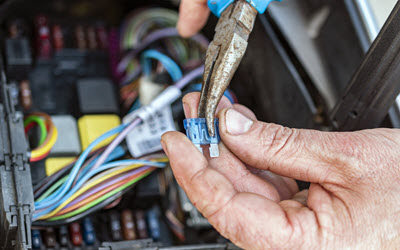Mercedes-Benz vehicles are known for their advanced electrical systems that power various components and functions within the vehicle. One crucial component of the electrical system is the fuse, which protects electrical circuits from overloading and short circuits. While most fuses are made of traditional materials like ceramic or plastic, Mercedes-Benz utilizes aluminum fuses in some of their models. These aluminum fuses have their own unique characteristics and potential failure points.
Electrical Component Failure
When an aluminum fuse fails, it can cause the electrical component or circuit it protects to stop functioning. If you notice that certain electrical components, such as the power windows, radio, or lights, suddenly stop working, it could be an indication of fuse failure.
It is important to note that multiple components may be affected if a single fuse is responsible for protecting several circuits. Therefore, if you experience multiple electrical failures simultaneously, it is advisable to check the fuses.
Fuse Blown Indicator
In some Mercedes-Benz models, there is a blown fuse indicator on the instrument cluster or a specific warning light that illuminates when a fuse fails. This indicator light is typically labeled “Fuse” or “F.” If you see this warning light illuminated on your dashboard, it is a clear indication that there is a fuse issue. Refer to your vehicle’s owner’s manual for more specific information regarding the location and function of the blown fuse indicator in your Mercedes-Benz model.
No Power to the Fuse
In certain cases, a failed aluminum fuse may show no signs of physical damage or visible blowout. However, upon testing, you may find that there is no power reaching the fuse. This can be determined using a multimeter or by seeking assistance from a qualified technician.
If power is not reaching the fuse, it may indicate a failure in the electrical circuit or a faulty fuse connection. In such instances, further inspection and diagnosis are necessary to identify the underlying cause.
Physical Damage or Melting
Aluminum fuses can also exhibit visible signs of physical damage or melting when they fail. Inspect the fuses carefully for any signs of discoloration, melting, or deformation. These visual indications suggest that the fuse has experienced excessive heat or overload, leading to its failure. If you notice any physical damage to the fuse, it is important to replace it promptly with a new one to ensure the proper functioning of the electrical system.
Intermittent Electrical Issues
In some cases, a failing aluminum fuse may cause intermittent electrical problems. You may experience sporadic issues with certain electrical components, such as lights flickering or intermittent power loss. These intermittent problems can be frustrating and difficult to diagnose, as the fuse may be functioning intermittently or on the verge of complete failure.
If you notice such issues, it is advisable to have the fuses and the associated electrical circuits inspected by a qualified technician to identify any underlying problems.
Repeated Fuse Failures
If you have replaced a fuse and it fails again shortly afterward, it may indicate an underlying issue within the electrical system. In some instances, a faulty electrical component or a short circuit can cause the fuse to blow repeatedly.
Continuing to replace the fuse without addressing the root cause can lead to further damage or electrical hazards. It is important to have the electrical system thoroughly inspected to identify and rectify the underlying issue causing the repeated fuse failures.
Diagnostic Trouble Codes (DTCs)
In modern Mercedes-Benz vehicles, the onboard diagnostic system can detect electrical faults and store Diagnostic Trouble Codes (DTCs) related to fuse failures or electrical issues. If you have access to an OBD-II scanner or diagnostic tool, you can retrieve these codes and use them as a guide for troubleshooting the fuse-related problems. The DTCs can provide valuable information about the specific circuit or component that is experiencing issues, aiding in the diagnosis and repair process.
Burning Smell or Smoke
In severe cases of fuse failure, you may detect a burning smell or notice smoke coming from the fuse box or the affected circuit. This indicates a serious electrical problem and should be addressed immediately. In such instances, it is crucial to turn off the vehicle and disconnect the battery to prevent further damage or potential fire hazards. Seek professional assistance from a qualified technician or contact roadside assistance to safely address the issue.
Mercedes Care at Heynneman European
Your Mercedes is a high-performing machine that  demands the utmost care and attention when it comes to maintenance and repairs. That’s why you need Heynneman European. We are your go-to destination for trustworthy and reliable care for your prized vehicle.
demands the utmost care and attention when it comes to maintenance and repairs. That’s why you need Heynneman European. We are your go-to destination for trustworthy and reliable care for your prized vehicle.
We proudly serve drivers from Larkspur, Kentfield, Corte, Mill Valley, San Anselmo, Fairfax, and San Rafael, CA, offering a comprehensive range of services and repairs to keep your car running smoothly and efficiently. Bring your Mercedes to Heynneman European today and experience the difference for yourself.

